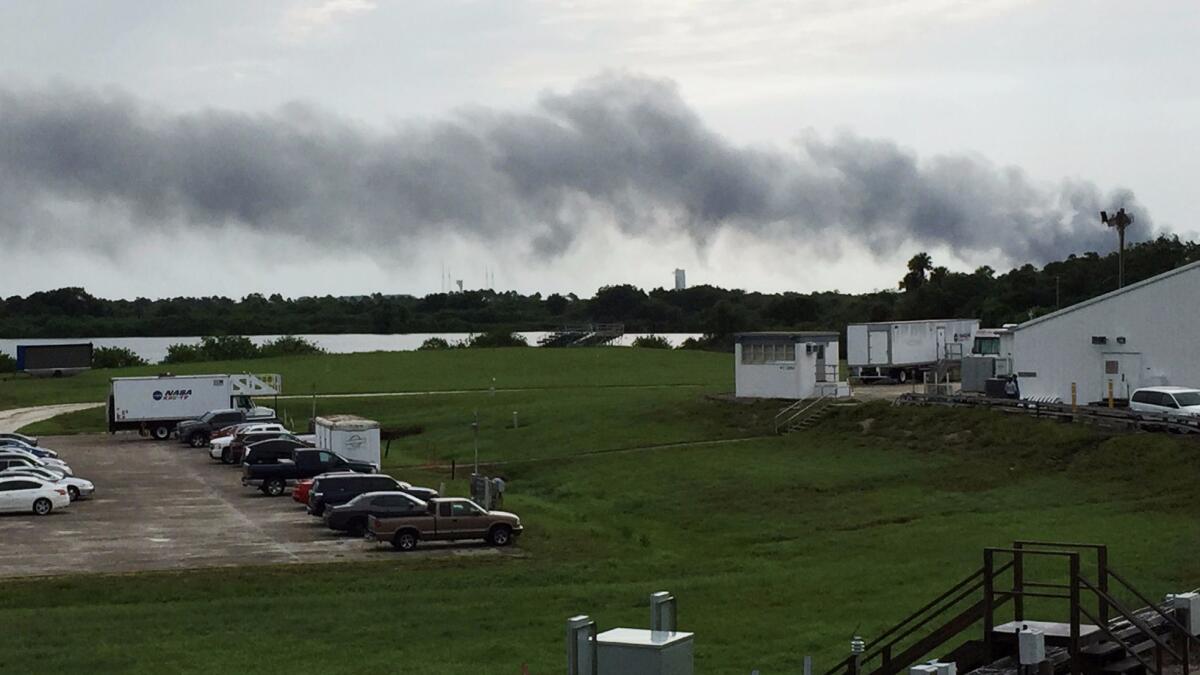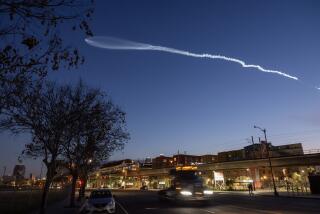NASA advisory committee questions SpaceX’s unorthodox fueling process

A NASA advisory committee has twice questioned SpaceX’s fueling process — a procedure that came under closer scrutiny after one of the company’s rockets exploded on a launch pad in September while being fueled.
The group’s concerns — expressed before and after the explosion — show ongoing doubt with the Hawthorne company’s unorthodox fueling practice as it plans to transport astronauts to the International Space Station. Those worries, analysts say, aren’t likely to affect the company’s return to flight, though they could delay SpaceX’s timeline for manned space station trips.
A member of the International Space Station advisory committee asked Monday how NASA will evaluate the safety of SpaceX’s fueling procedure when astronauts are on board as part of the commercial crew program. This question was first raised in a letter in December 2015, according to the Wall Street Journal, 10 months before the explosion that destroyed one of SpaceX’s Falcon 9 rockets and a commercial communications satellite.
Watch the September explosion below >>

A SpaceX rocket carrying a satellite for Facebook exploded on the launchpad in September.
The advisory committee provides recommendations to NASA on issues related to the International Space Station, including spaceflight safety, readiness of missions to the space station and crew health. Its recommendations are not binding.
SpaceX’s investigation of the cause of the explosion has narrowed to one of three composite overwrapped pressure vessels, which store helium that helps pressurize the liquid oxygen tank in the rocket’s second stage. The Hawthorne company said it was able to re-create a failure in one of those pressure vessels “entirely through helium loading conditions,” which are primarily affected by the temperature and pressure of the helium being loaded.
SpaceX said Friday that it was focused on confirming a root cause of the explosion and “developing improved helium loading conditions that allow SpaceX to reliably load Falcon 9.”
The company loads fuel into its rockets differently than other aerospace companies. SpaceX uses superchilled liquid oxygen so it can pack more fuel into the tank and increase its power at liftoff to hoist heavy payloads. But to keep the fuel at that low temperature and maximize the efficiency, the company has to fuel up the rocket right before launch.
When SpaceX eventually takes astronauts to the International Space Station, the company said crew will be on board the spacecraft while propellant is being loaded into the rocket. During that time, the Crew Dragon spacecraft launch abort system will be enabled.
“I’m not aware that in any other U.S. human spaceflight launch, the booster is fueled after the crew is aboard,” said John Logsdon, professor emeritus of the Space Policy Institute at George Washington University. “It’s a deviation from the norm, and that’s bound to raise concerns.”
In a December 2015 letter to NASA headquarters, International Space Station advisory committee Chairman Lt. Gen. Thomas Stafford said that fueling a rocket with the crew on board was counter to decades of international space launch policies, according to the Wall Street Journal.
NASA supervises the commercial crew program, in which SpaceX and Boeing Co. are building spacecraft to ferry astronauts to the International Space Station. Since the space shuttle program ended in 2011, NASA has relied on the Russian Federal Space Agency to take U.S. astronauts to the station.
They’ve got to start playing it safe.
— Marco Caceres, senior space analyst at Teal Group
SpaceX said it has worked with NASA for a year and a half on a “detailed analysis of all potential hazards with this process.” A report documenting safeguards against these hazards was approved by NASA’s safety technical review board in July, SpaceX said.
“There will be continued work ahead to show that all of these controls are in place for crewed operations and that the verifications meet NASA requirements,” SpaceX said. “These analyses and controls will be carefully evaluated in light of all data and corrective actions resulting from the anomaly investigation.”
In a statement Tuesday, NASA said the spacecraft and rockets set to transport astronauts must meet NASA’s safety and technical requirements before the agency will certify them to carry humans.
NASA said it is working through a “rigorous review process” with both companies and will continue to evaluate SpaceX’s process for fueling the Falcon 9 rocket for commercial crew launches.
The results of the explosion investigation will also be incorporated into NASA’s evaluation, the agency said.
Analysts said the committee’s concerns about the fuel-loading process could mean a delay in the timeline of the commercial crew program.
See the most-read stories in Business this hour »
“The safety standard for carrying humans is much higher than for carrying satellites,” Bill Ostrove, aerospace and defense analyst at Forecast International, said in an email.
SpaceX has said it plans to launch its first crewed mission to the space station in late 2017, though a NASA Office of Inspector General’s report released in September said a crewed flight was more likely to occur in late 2018.
“They’ve got to start playing it safe,” said Marco Caceres, senior space analyst at Teal Group. “They are more of an establishment player and they’ve got a relatively good reputation. They have something to lose now.”
For more business news, follow me @smasunaga
ALSO
Trips to Mars won’t make quick money, but venture capitalists are jumping on other space projects
NASA delivery company launches supplies to space station for first time in two years
Cosmic radiation may leave astronauts with long-term cases of ‘space brain,’ study says
More to Read
Inside the business of entertainment
The Wide Shot brings you news, analysis and insights on everything from streaming wars to production — and what it all means for the future.
You may occasionally receive promotional content from the Los Angeles Times.











